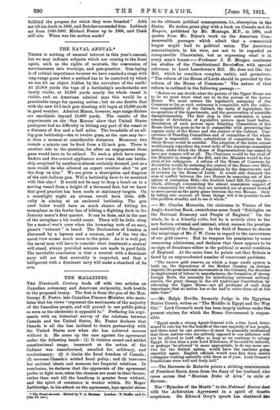THE NATAL ANNUAL*
THERE is nothing of unusual interest in this year's annual, but we may indicate subjects which are coming to the front again, such as the rights of neutrals, the coaversion of merchantmen into warships, and gun-practice. Gun-laying is of critical importance because we have reached a stage with tong-range guns when a method has to be contrived by which we can bit an object bidden by the curvature of the earth! At 25,000 yards the tops of a battleship's smokestacks are barely visible, at 10,000 yards nearly the whole vessel is visible, and an American admiral says this would be a practicable range for opening action ; but no one doubts that with the new 13 5-inch gun shooting will begin at 12,000 yards in good weather. Admiral Mason, however, says range-finders are unreliable beyond 10,000 yards. The results of the experiments on the San Marcos' show that United States gunlayers had no difficulty in hitting any part of the vessel at a distance of five and a half miles. The broadside of an all- big-gun battleship—ten or twelve guns, as the case may be— is thus a menace at considerable distances. Moreover, two rounds a minute can be fired from a 12-inch gun. There is another aide to the question, for after an engagement these guns would have to be relined. To such a pitch have range- finders and fire-control appliances now come that one battle- ship surprised by another is-almost certainly doomed, just as a man would be who allowed an expert revolver shot "to get the drop on him." We are given a description and diagram of the anti-balloon gun. Will a battleship have to be mounted with this also ? It would not be easy to drop a bomb on to a moving vessel from a height of a thousand feet, but we know that good practice has been made at stationary targets. On , a moonlight night an airman would have little diffi- culty in aiming at an anchored battleship. The gun crew below would have as much chance of bitting his monoplane as the fowler has of hitting a fighting duck in the January moon's first quarter. It can be done, and in the case of the aeroplane a hit would count. There will be little sleep for a man-o'-war's crew when the humming note of an aero., plane's " exhaust " is heard. The Declaration of London is discussed by a layman and a seaman, and of the two the naval view seems much more to the point. As it is well put, the naval man will have to consider what treatment a neutral will stand, always provided seizures are made in good faith. The inevitable conclusion is that a neutral with a dominant navy will see that neutrality is respected, and that a belligerent with a dominant navy will make a standard of its own.










































 Previous page
Previous page